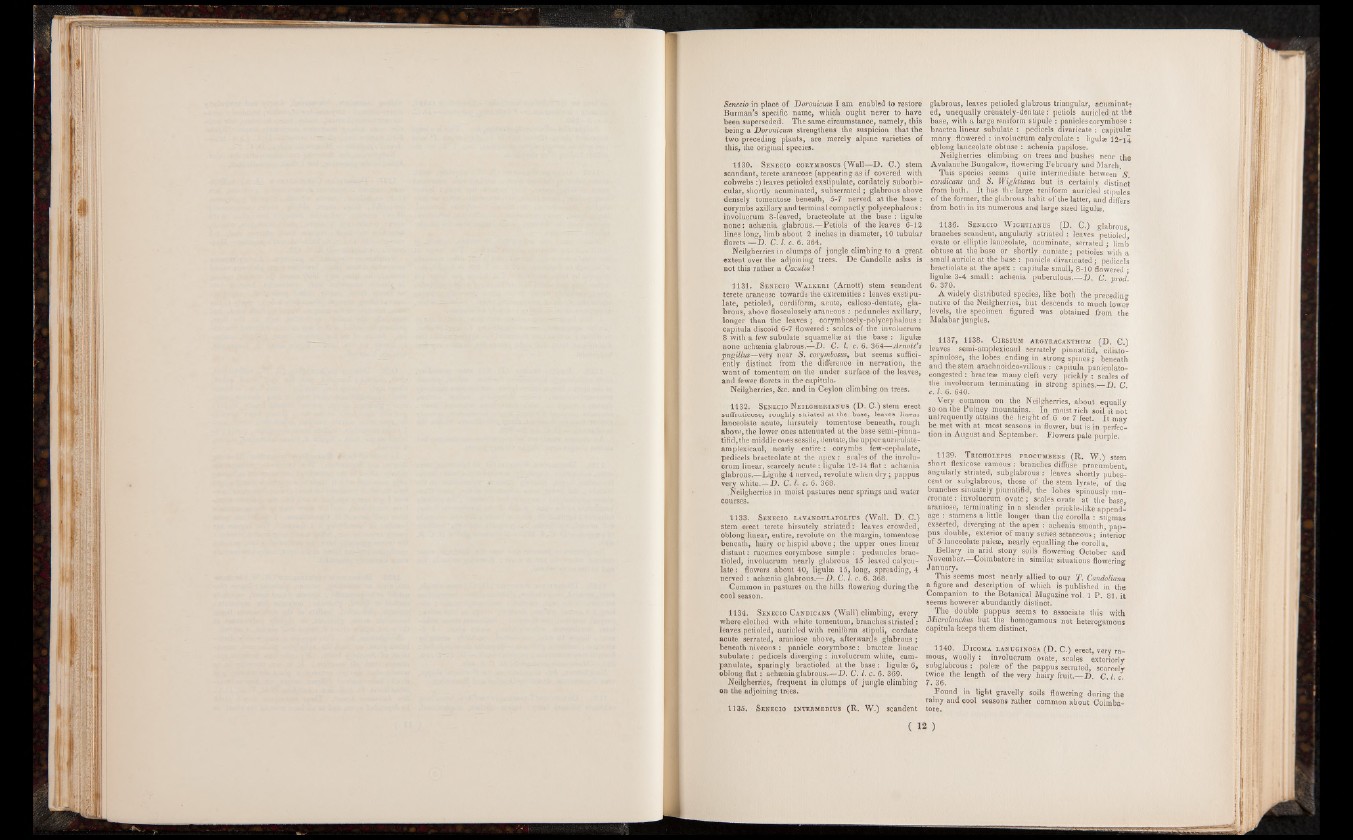
Senecio in place of Doronicum I am enabled to restore
Burman’s specific name, which ought never to have
been superseded. The same circumstance, namely, this
being a Doronicum strengthens the suspicion that the
two preceding plants, are merely alpine varieties of
this, the original species.
1130. Senecio corymbosus (Wall—D. C.) stem
scandant, terete araneose (appearing as if covered with
cobwebs:) leaves petioled exstipulate, cordately suborbi-
cular, shortly acuminated, subserrated ; glabrous above
densely tomentose beneath, 5-7 nerved at the base :
corymbs axillary and terminal compactly polycephalous:
involucrum 8-leaved, bracteolate at the base : ligulae
none: achaenia glabrous.—Petiols of the leaves 6-12
lines long, limb about 2 inches in diameter, 10 tubular
florets —D. C. 1. c. 6. 364.
Neilgherries in clumps of jungle climbing to a great
extent over the adjoining trees. De Candolle asks is
not this rather a Cacalia 1
1131. Senecio Walkeri (Arnott) stem scandent
terete araneose towards the extremities: leaves exstipulate,
petioled, cordiform, acute, calloso-dentate, glabrous,
above flosculosely araneous : peduncles axillary,
longer than the leaves ; corymbosely-polycephalous:
capitula discoid 6-7 flowered : scales of the involucrum
8 with a few subulate squamellae'at the base: ligulae
none achaenia glabrous.—D. C. 1. c. 6. 364—Arnott's
pugillus—very near S. corymbosus, but seems sufficiently
distinct from the difference in nervation, the
want of tomentum on the under surface of the leaves,
and fewer florets in the capitula.
Neilgherries, &c. and in Ceylon climbing on trees.
1132. Senecio Neilgherianus (D. C.) stem erect
suffruticose, roughly striated at the base, leaves linear
lanceolate acute, hirsutely tomentose beneath, rough
above, the lower ones attenuated at the base semi-pinna-
tifid, the middle ones sessile, dentate,the upper auriculate-
amplexicaul, nearly entire: corymbs few-cephalate,
pedicels bracteolate at the apex : scales of the involucrum
linear, scarcely acute : ligulae 12-14 flat : achaenia
glabrous.—Ligulae 4 nerved, revolute when dry; pappus
very white.—D. C. 1. c. 6. 368.
,Neilgherries in moist pastures near springs and water
courses.
1133. Senecio lavandulafolius (Wall. D. C.)
stem erect terete hirsutely striated: leaves crowded,
oblong linear, entire, revolute on the margin, tomentose
beneath, hairy or hispid above; the upper ones linear
distant: racemes corymbose simple : peduncles brac-
tioled, involucrum nearly glabrous 15 leaved calculate:
flowers about 40, ligulae 15, long, spreading, 4
nerved : achaenia glabrous.—D. C. 1. c. 6. 368.
Common in pastures on the hills flowering during the
cool season.
1134. Senecio Candicans (Wall) climbing, every
where clothed with white tomentum, branches striated :
leaves petioled, auricled with reniform stipuli, cordate
acute serrated, araniose above, afterwards glabrous ;
beneath niveous : panicle corymbose: bracteae linear
subulate : pedicels diverging: involucrum white, cam-
panulate, sparingly bractioled at the base : ligulae 6,
oblong flat: achaenia glabrous.—D. C. 1. c. 6. 369.
Neilgherries, frequent in clumps of jungle climbing
on the adjoining trees.
1135. Senecio intermedius (R. W.) scandent
glabrous, leaves petioled glabrous triangular, acuminated,
unequally crenately-dentate: petiols auricled at the
base, with a large reniform stipule : panicles corymbose :
bractea linear subulate : pedicels divaricate : capitulae
many flowered : involucrum calyculate : ligulae 12-14
oblong lanceolate obtuse : achenia papilose.
Neilgherries climbing on trees and bushes near the
Avalanche Bungalow, flowering February and March.
This species seems quite intermediate between S.
candicans and S. Wightiana but is certainly distinct
from both. It has the large reniform auricled stipules
of the former, the glabrous habit of the latter, and differs
from both in its numerous and large sized ligulae.
1136. Senecio W ightianus (D. C.) glabrous
branches scandent, angularly striated : leaves petioled*
ovate or elliptic lanceolate, acuminate, serrated • limb
obtuse at the base or shortly cuniate; petioles with a
small auricle at the base : panicle divaricated; pedicels
bractiolate at the apex : capitulae small, 8-10 flowered •
ligulae 3-4 small: achenia puberulous.—D. C. prod’
6. 370.
A widely distributed species, like both the preceding
native of the Neilgherries, but descends to much lower
levels, the specimen figured was obtained from the
Malabar jungles.
1137, 1138. Cirsium ARGYRACANTHUM (D. C.)
leaves semi-amplexicaul serrately pinnatifid, ciliato-
spinulose, the lobes ending in strong spines ; beneath
and the stem arachnoideo-villous : capitula paniculato-
eongested: bracteae many cleft very prickly : scales of
the involucrum terminating in strong spines.—D. C
c. 1. 6. 640.
Very common on the Neilgherries, about equally
so on the Pulney mountains. In moist rich soil it not
unfrequently attains the height of 6 or 7 feet. It may
be met with at most seasons in flower, but is in perfection
in August and September. Flowers pale purple.
1139. Tricholepis procumbens (R. W.) stem
short flexicose ramous : branches diffuse procumbent
angularly striated, subglabrous : leaves shortly pubescent
or subglabrous, those of the stem lyrate, of the
branches sinuately pinnatifid, the lobes spinously mu-
cron ate : involucrum ovate; scales ovate at the base
araniose, terminating in a slender prickle-like appendage
: stamens a little longer than the corolla : stigmas
exserted, diverging at the apex : achenia smooth, pappus
double, exterior of many series setaceous; interior
of 5 lanceolate paleae, nearly equalling the corolla,
Bellary in arid stony soils flowering October and
November.—Coimbatore in similar situations flowering
January.
This seems most nearly allied to our T. Candoliana
a figure and description of which is published in the
Companion to the Botanical Magazine vol. I P . 81. it
seems however abundantly distinct.
The double pappus seems to associate this with
Microlonchus but the homogamous not heterogamous
capitula keeps them distinct.
1140. D icoma lanuginosa (D. C.) erect, very ramous,
woolly : involucrum ovate, scales exteriorly
subglabrous : paleae of the pappus serrated, scarcely
twice the length of the very hairy fruit.—D C l c
7. 36.
Found in light gravelly soils flowering during the
rainy and cool seasons rather common about Coimbatore.